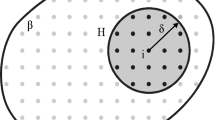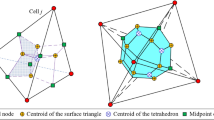Abstract
For pin-jointed assemblies with many members or self-stress states, the form-finding problem using conventional methods generally involves considerable computational complexities due to the large size of the solution spaces. Here, we propose an improved form-finding method for prestressable pin-jointed structures by combining symmetry-based qualitative analysis with particle swarm optimization. Expressed in the symmetry-adapted coordinate system, the nodal coordinate vectors of a structure with specific symmetry and topology are independently extracted from the key blocks of the small-sized force density matrices associated with rigid-body translations. Then, the first block of the equilibrium matrix is computed, in which the null space reveals integral self-stress states. Particle swarm optimization is introduced and adapted to find feasible prestress modes, where the uniformity and unilaterality conditions of the members are considered. Besides, the QR decomposition with column pivoting is adopted for efficient computations on the null space of these blocks. The QR decompositions of the small-sized blocks of the force density matrix and the equilibrium matrix are performed iteratively, to simultaneously find a stable self-equilibrium configuration and a feasible prestress mode. Representative examples show the presented method is computationally efficient and accurate for the form-finding of symmetric tensegrities and prestressed cable–strut structures.










Similar content being viewed by others
References
Veenendaal, D., Block, P.: An overview and comparison of structural form finding methods for general networks. Int J. Solids Struct 49, 3741–3753 (2012)
Motro, R.: Tensegrity: Structural Systems for the Future Kogan Page Science. Elsevier, London (2003)
Wang, B., Guan, S., Zhang, Y., Bai, Y.: Experimental behavior and failure modes of hybrid beam-to-column connections with RC wing-walls in industrial construction. Constr. Build. Mater. 218, 628–643 (2019)
Chen, Y., Feng, J., Zhang, Y.T.: A necessary condition for stability of kinematically indeterminate pin-jointed structures with symmetry. Mech. Res. Commun. 60, 64–73 (2014)
Chen, Y., Yan, J., Sareh, P., Feng, J.: Nodal flexibility and kinematic indeterminacy analyses of symmetric tensegrity structures using orbits of nodes. Int. J. Mech Sci. 155, 41–49 (2019)
Levy, M.P., Jing, T.F.: Floating saddle connections for the Georgia Dome. USA. Struct. Eng. Int. 4, 148–150 (1994)
Zhang, L.Y., Zhu, S.X., Li, S.X., Xu, G.K.: Analytical form-finding of tensegrities using determinant of force–density matrix. Compos. Struct. 189, 87–98 (2018)
Koohestani, K.: On the analytical form-finding of tensegrities. Compos. Struct. 166, 114–119 (2017)
Jordán, T., Recski, A., Szabadka, Z.: Rigid tensegrity labelings of graphs. Eur J. Combin. 30, 1887–1895 (2009)
Connelly, R., Whiteley, W.: Second-order rigidity and prestress stability for tensegrity frameworks. SIAM J. Discrete Math. 9, 453–491 (1996)
Ingber, D.E.: Cell structure and hierarchical systems biology. J. Cell Sci 116, 1157 (2003)
Stamenović, D.: Effects of cytoskeletal prestress on cell rheological behavior. Acta Biomater. 1, 255–262 (2005)
Feng, F.: Structural behavior and design methods of Tensegrity domes. J. Constr. Steel Res. 61, 23–35 (2005)
Tran, H.C., Lee, J.: Initial self-stress design of tensegrity grid structures. Comput. Struct. 88, 558–566 (2010)
Koohestani, K., Guest, S.D.: A new approach to the analytical and numerical form-finding of tensegrity structures. Int. J. Solids Struct. 50, 2995–3007 (2013)
Chen, Y., Feng, J., Wu, Y.: Novel form-finding of tensegrity structures using ant colony systems. J. Mech. Robot. Trans. ASME 4, 1283–1289 (2012)
Gasparini, D., Klinka, K.K., Arcaro, V.F.: A finite element for form-finding and static analysis of tensegrity structures. J. Mech. Mater. Struct. 6, 1239–1253 (2011)
Zhang, J.Y., Ohsaki, M.: Adaptive force density method for form-finding problem of tensegrity structures. Int. J. Solids Struct. 43, 5658–5673 (2006)
Feng, X.: The optimal initial self-stress design for tensegrity grid structures. Comput. Struct. 193, 21–30 (2017)
Aloui, O., Flores, J., Orden, D., Rhode-Barbarigos, L.: Cellular morphogenesis of three-dimensional tensegrity structures. Comput. Method Appl. Mech. 346, 85–108 (2019)
Masic, M., Skelton, R.E., Gill, P.E.: Algebraic tensegrity form-finding. Int. J. Solids Struct. 42, 4833–4858 (2005)
Connelly, R., Back, A.: Mathematics and Tensegrity: Group and representation theory make it possible to form a complete catalogue of “strut-cable” constructions with prescribed symmetries. Am. Sci. 86, 142–151 (1998)
Zhang, J.Y., Guest, S.D., Ohsaki, M.: Symmetric prismatic tensegrity structures. Part II: Symmetry-adapted formulations. Int. J. Solids Struct. 46, 15–30 (2009)
Chen, Y., Sun, Q., Feng, J.: Group-theoretical form-finding of cable-strut structures based on irreducible representations for rigid-body translations. Int. J. Mech. Sci. 144, 205–215 (2018)
Chen, Y., Feng, J., Ma, R., Zhang, Y.: Efficient symmetry method for calculating integral prestress modes of statically indeterminate cable-strut structures. J. Struct. Eng. ASCE 141, 04014240 (2015)
Kaveh, A., Daei, M.: Efficient force method for the analysis of finite element models comprising of triangular elements using ant colony optimization. Finite Elem. Anal. Des. 45, 710–720 (2009)
Kaveh, A., Daei, M.: Suboptimal cycle bases of graphs using ant colony system algorithm. Eng. Comput. 27, 485–494 (2010)
Kaveh, A., Bakhshpoori, T.: Metaheuristics: Outlines. MATLAB Codes and Examples. Springer, Switzerland (2019)
Rieffel, J., Valero-Cuevas, F., Lipson, H.: Automated discovery and optimization of large irregular tensegrity structures. Comput. Struct. 87, 368–379 (2009)
Lee, S., Woo, B.H., Lee, J.: Self-stress design of tensegrity grid structures using genetic algorithm. Int. J. Mech. Sci. 79, 38–46 (2014)
Koohestani, K.: Form-finding of tensegrity structures via genetic algorithm. Int. J. Solids Struct. 49, 739–747 (2012)
Tran, H.C., Lee, J.: Advanced form-finding of tensegrity structures. Comput. Struct. 88, 237–246 (2010)
Li, Y., Feng, X.Q., Cao, Y.P., Gao, H.: A Monte Carlo form-finding method for large scale regular and irregular tensegrity structures. Int. J. Solids Struct. 47, 1888–1898 (2010)
Xu, X., Wang, Y., Luo, Y.: Finding member connectivities and nodal positions of tensegrity structures based on force density method and mixed integer nonlinear programming. Eng. Struct. 166, 240–250 (2018)
Zingoni, A.: Group-theoretic exploitations of symmetry in computational solid and structural mechanics. Int. J. Numer. Meth. Eng. 79, 253–289 (2009)
Kaveh, A., Rahami, H., Nikbakht, M.: Vibration analysis of regular structures by graph products: cable networks. Comput. Struct. 88, 588–601 (2010)
Chen, Y., Feng, J., Lv, H., Sun, Q.: Symmetry representations and elastic redundancy for members of tensegrity structures. Compos. Struct. 203, 672–680 (2018)
Kaveh, A.: Optimal Analysis of Structures by Concepts of Symmetry and Regularity. Springer, Wien (2013)
Chen, Y., Sareh, P., Yan, J., Fallah, A.S., Feng, J.: An integrated geometric-graph-theoretic approach to representing origami structures and their corresponding truss frameworks. J. Mech. Des. Trans. ASME 141, 091402 (2019)
Chen, Y., Feng, J., Sun, Q.: Lower-order symmetric mechanism modes and bifurcation behavior of deployable bar structures with cyclic symmetry. Int. J. Solids Struct. 139–140, 1–14 (2018)
Sareh, P., Guest, S.D.: Designing symmetric derivatives of the Miura-ori. In: Advances in Architectural Geometry, pp. 233–241 (2014)
Sareh, P.: Symmetric descendants of the Miura-ori. Engineering Department, University of Cambridge, UK (2014)
Pellegrino, S., Tibert, A.G.: Review of form-finding methods for tensegrity structures. Int. J. Space Struct. 18, 209–223 (2011)
Chen, Y., Feng, J.: Generalized eigenvalue analysis of symmetric prestressed structures using group theory. J. Comput. Civil Eng. ASCE 26, 488–497 (2012)
Tran, H.C., Lee, J.: Advanced form-finding for cable-strut structures. Int. J. Solids Struct. 47, 1785–1794 (2010)
Altmann, S.L., Herzig, P.: Point-Group Theory Tables. Clarendon Press, Oxford (1994)
Chen, Y., Feng, J.: Efficient method for Moore-Penrose inverse problems involving symmetric structures based on group theory. J. Comput. Civil Eng. ASCE 28, 182–190 (2014)
Katsikis, V.N., Pappas, D., Petralias, A.: An improved method for the computation of the MoorePenrose inverse matrix. Appl. Math. Comput. 217, 9828–9834 (2011)
Zhang, J.Y., Ohsaki, M.: Stability conditions for tensegrity structures. Int. J. Solids Struct. 44, 3875–3886 (2007)
Chen, Y., Feng, J., Wu, Y.: Prestress stability of pin-jointed assemblies using ant colony systems. Mech. Res. Commun. 41, 30–36 (2012)
Motro, R., Vassart, N.: Tensegrity systems. Int. J. Space Struct. 18, 77–84 (2009)
Zhang, J.Y., Ohsaki, M.: Force identification of prestressed pin-jointed structures. Comput. Struct. 89, 2361–2368 (2011)
Kennedy, J.: Particle swarm optimization. In: Encyclopedia of Machine Learning, pp. 760–766. Springer, Berlin (2011)
Kaveh, A., Zolghadr, A.: Democratic PSO for truss layout and size optimization with frequency constraints. Comput. Struct. 130, 10–21 (2014)
Kaveh, A., Talatahari, S.: Particle swarm optimizer, ant colony strategy and harmony search scheme hybridized for optimization of truss structures. Comput. Struct. 87, 267–283 (2009)
Ohsaki, M., Zhang, J., Elishakoff, I.: Multiobjective hybrid optimization-antioptimization for force design of tensegrity structures. J. Appl. Mech. Trans. ASME 79, 021015 (2012)
Acknowledgements
This work was supported by the National Natural Science Foundation of China (Grant Numbers 51508089 and 51850410513), Southeast University “Zhongying Young Scholars” Project, and the Fundamental Research Funds for the Central Universities. The first author would like to acknowledge financial support from the Alexander von Humboldt Foundation for his visiting research at Max-Planck-Institut für Eisenforschung GmbH, Germany. The last author would like to acknowledge the award of Research Fund for International Young Scientists from the National Natural Science Foundation of China. The authors are grateful to the editors and anonymous reviewers for their professional comments and valuable suggestions in improving the quality of the paper.
Author information
Authors and Affiliations
Corresponding author
Additional information
Publisher's Note
Springer Nature remains neutral with regard to jurisdictional claims in published maps and institutional affiliations.
Rights and permissions
About this article
Cite this article
Chen, Y., Yan, J., Feng, J. et al. A hybrid symmetry–PSO approach to finding the self-equilibrium configurations of prestressable pin-jointed assemblies. Acta Mech 231, 1485–1501 (2020). https://doi.org/10.1007/s00707-019-02586-6
Received:
Revised:
Published:
Issue Date:
DOI: https://doi.org/10.1007/s00707-019-02586-6




